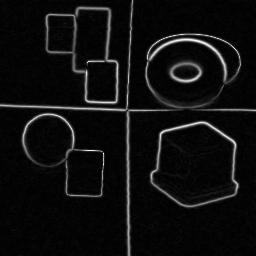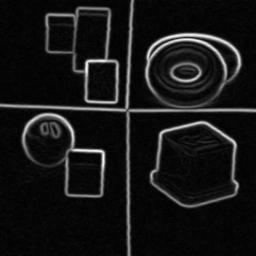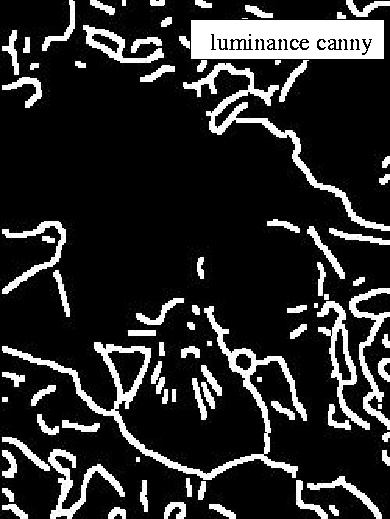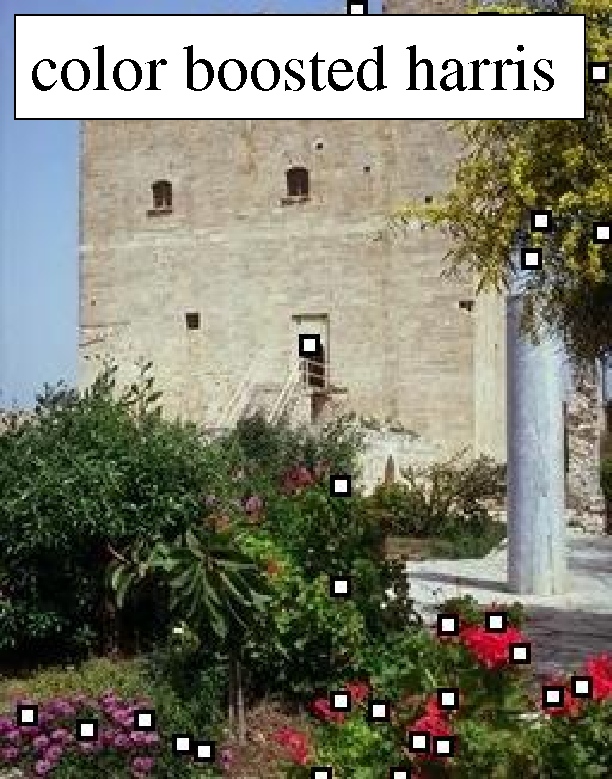Photometric Invariant Edge Detection


 By using a physical reflection model it is possible to differentiate between different physical causes of edges. It is for example
possible to differ between scene incidental edges such as shadow, shading and specular edges, and high informative edges such as material edges.
By using a physical reflection model it is possible to differentiate between different physical causes of edges. It is for example
possible to differ between scene incidental edges such as shadow, shading and specular edges, and high informative edges such as material edges.
The example on a toy image shows two photometrically invariant edge detectors, coined quasi-invariants. The first edge-image shows the results of the shadow-shading quasi-invariant which does not respond to shading, shadow edges, such as the shading edges on the green-block, and the shadow edge on the ground next to the red ball. It does however respond to specularities, as can be seen on the red ball and the yellow torus. The second edge-image shows the results of the shadow-shading and specular quasi-invariant. In this image also the specular edges are removed, such as the highlight on the red ball. Only the more informative material edges are detected.
Color Canny


 When asked about the importance of color, Picasso in one of his blue years
exclaimed: "Colors are only symbols. Reality is to be found in luminance alone."
His message seems to be taken to heart by the computer vision community. In general the first thing to do,
when trying to interpret the content of images is to discard color.
When asked about the importance of color, Picasso in one of his blue years
exclaimed: "Colors are only symbols. Reality is to be found in luminance alone."
His message seems to be taken to heart by the computer vision community. In general the first thing to do,
when trying to interpret the content of images is to discard color.
In the case of iso-luminance the transformation from color to luminance has the undesired consequence that information is lost. Iso-luminance is the phenomenon
where two colors have a similar luminance value, and edges appearing in the color image, disappear in its luminance representation. In the figure on the right such an example of an iso-luminance edge is given. The purple of the foreground and the green of the background have similar luminance values, and the edge is not detected by the luminance Canny algorithm. On the other hand, the color edges detected with Canny nicely folow the outline of the flower.
Color Harris and Color Boosting

 Variations in the real-world are dominated by luminance variation and the contrast caused by color variation (when measured in RGB-space) are much smaller. This causes color feature detectors to often return similar results as luminance-based detectors. For example for the Harris detector: luminance and color Harris return both similar interest points, which are predominantly caused by luminance variations. This is illustrated in the images to the right, where the 20 most prominent points per detector are depicted. To emphasize the higher information content of colorful points in the image, one should amplify the contrast in the chromaticity channels. The color boosted results are given in the final image to right; in this case the interestpoints contain more colorful events, which are often more informative in for example a recognition or retrieval task. A derivation of color boosting from information theory and color image statistics can be found in this
paper.
Variations in the real-world are dominated by luminance variation and the contrast caused by color variation (when measured in RGB-space) are much smaller. This causes color feature detectors to often return similar results as luminance-based detectors. For example for the Harris detector: luminance and color Harris return both similar interest points, which are predominantly caused by luminance variations. This is illustrated in the images to the right, where the 20 most prominent points per detector are depicted. To emphasize the higher information content of colorful points in the image, one should amplify the contrast in the chromaticity channels. The color boosted results are given in the final image to right; in this case the interestpoints contain more colorful events, which are often more informative in for example a recognition or retrieval task. A derivation of color boosting from information theory and color image statistics can be found in this
paper.
Download Code
Here is matlab code for some of the color image processing functions discussed above, including: photometric invariant and color Canny edge detection and Harris point detection. It has not been optimized for speed, so feel free to adapt.